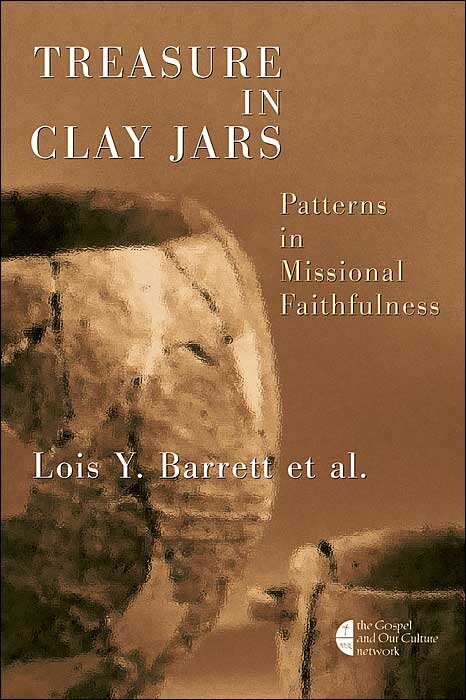Lois Y. Barrett, et al, Treasure in Clay Jars: Patterns in Missional Faithfulness. Grand Rapids: Eerdmans, 2004.
Referenced in: Missional Communities – Missio Dei
LifeandLeadership.com Summary
This is part of the acclaimed Gospel and Our Culture Series. When the network produced Missional Church, the question emerged as to whether the missional church was strictly academic or actually manifested itself tangibly. Thus GOCN commissioned the Developing Congregational Models research team to “identify and define tangible congregational models of, and resources for, implementing a missional understanding of the church.” (p. 154). Treasures in Clay Jars is the result of their research, with sketches of nine congregations that exhibit eight “patterns of faithfulness” in their quest to become missional. Treasures contains essays from the team on each of the patterns, then case descriptions of how these characteristics are reflected in the nine researched churches and presumably in all congregations seeking to participate in God’s mission in the world. Below is a brief summary of the eight patterns.
Pattern 1, Missional Vocation – The congregation is discovering together the missional vocation of the community. It is beginning to redefine “success” and “vitality” in terms of faithfulness to God’s calling and sending. It is seeking to discern God’s specific missional vocation (“charisms” – gifts) for the entire community and for all of its members.
Pattern 2, Biblical Formation and Discipleship – The missional church is a community in which all members are involved in learning what it means to be disciples of Jesus. The bible is normative in this church’s life. Biblical formation and discipling are essential for the congregation.
Pattern 3, Taking Risks as a Contrast Community – The missional church is learning to take risks for the sake of the gospel. It understands itself as different from the world because of its participation in the life, death and resurrection of its Lord. It is raising questions, often threatening ones, about the church’s cultural captivity, and it is grappling with the ethical and structural implications of its missional vocation. It is learning to deal with internal and external resistance.
Pattern 4, Practices That Demonstrate God’s Intent for the World – The pattern of the church’s life as community is a demonstration of what God intends for the life of the whole world. The practices of the church embody mutual care, reconciliation, loving accountability, and hospitality. A missional church is indicated by how Christians behave toward one another.
Pattern 5, Worship as Public Witness – Worship is the central act by which the community celebrates with joy and thanksgiving both God’s presence and God’s promised future. Flowing out of its worship, the community has a vital public witness.
Pattern 6, Dependence on the Holy Spirit – The missional community confesses its dependence upon the Holy Spirit, shown in particular in its practices of corporate prayer.
Pattern 7, Pointing Toward the Reign of God – The missional church understands its calling as witness to the gospel of the in-breaking reign of God, and strives to be an instrument, agent, and sign of that reign. As it makes its witness through its identity, activity, and communication, it is keenly aware of the provisional character of all that it is and does. It points towards the reign of God that God will certainly bring about, but knows that its own response is incomplete, and that its own conversion is a continuing necessity.
Pattern 8, Missional Authority – The Holy Spirit gives the missional church a community a community of persons who, in a variety of ways and with a diversity of functional roles and titles, together practice the missional authority that cultivates within the community the discernment of missional vocation and is intentional about the practices that embed that vocation in the community’s life.
From the Publisher
If you saw a missional church, what would it look like? What patterns of behavior and practice would you find there?
Building on the ground laid by the book Missional Church: A Vision for the Sending of the Church in North America (Darrell Guder et al. 1998), Treasure in Clay Jars centers on case studies of nine missional congregations from across North America that are diverse in their denominational affiliations, worship styles, political stances, and socioeconomic backgrounds. The book explores eight concrete -patterns- common to these churches. Although the patterns may be different in each setting, they can be recognized in any congregation seeking to participate in God-s mission in the world.
The team that authored this book believes that -missional- says something not so much about the activities of the church as its character: -The church does not exist for itself, but for participation in God-s mission of reconciliation… . Mission is the character of the church in whatever context it exists.- The congregations studied here are -clay jars,- but each carries in its witness a remarkable treasure that points to God-s power and purposes.
About the Author
Lois Y. Barrett is Director and Associate Professor of Theology and Anabaptist Studies at Associated Mennonite Biblical Seminary, Great Plains.
***For additional information on this resource, including reviews, click the bookstore links. Check the reference at page top or the links below for resource guides on related topics.***
See Resource Guides on Related Areas:
- Missional Perspectives, Introduction
- Missional Church Resources, Introduction and Index
- Church Leadership and Renewal, Index to Resources
See Resources on Over 100 Areas of Ministry Leadership:


